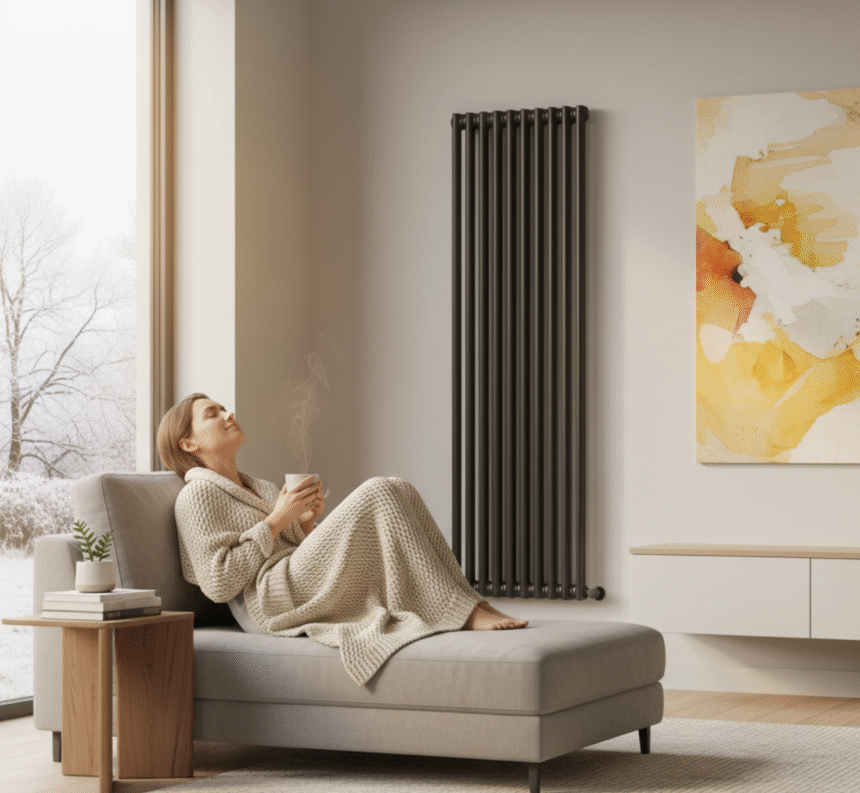There’s something deeply comforting about stepping into a warm room on a cold day. Beyond the physical relief, warmth has a powerful psychological effect. It helps us feel safe, relaxed, and emotionally balanced. While we often think of heating as purely functional, modern radiators play a quiet but essential role in shaping our mood and productivity.
As homes and workspaces evolve, designers and homeowners alike are recognising that warmth isn’t just about temperature; it’s about creating an atmosphere that supports both comfort and focus.
1. The Science Behind Warmth and Human Behaviour
Alt: A woman working in front of a radiator for relaxation
Scientific studies have long shown that our environment directly influences how we feel and think. Warm temperatures are often associated with emotional security and happiness, while cold spaces can make people feel withdrawn or distracted.
Consistent indoor temperatures maintained by efficient radiators help regulate not just our bodies but also our mental state. When our surroundings feel balanced, we become calmer, more social, and better equipped to focus on all key ingredients for both productivity and overall well-being.
2. Warmth and Mood: The Comfort Connection
Feeling warm goes hand in hand with feeling content. Warm spaces tend to reduce levels of stress hormones, making us feel calmer and more at ease. That’s why so many of us instinctively gather near our heating source, whether it’s a living room radiator or a cosy heated towel rail in the bathroom.
A well-heated room provides more than comfort; it creates emotional safety. The gentle, consistent heat from a quality system helps transform a simple room into a personal retreat, perfect for unwinding after a long day.
3. Productivity and Focus: Why Temperature Control Matters
It’s not just our mood that benefits from warmth; our ability to work and concentrate does too. Research shows that the optimal indoor temperature for productivity typically falls between 20°C and 22°C. Anything colder can make people sluggish or distracted, while too much heat can lead to fatigue.
Modern smart radiators and thermostatic valves help maintain this delicate balance effortlessly. With programmable settings, you can set different temperatures for work and relaxation, ensuring comfort without wasting energy. This fine-tuned control helps create an environment where you can focus better, think clearly, and stay motivated, especially during long winter days.
4. The Role of Radiator Design in Creating Emotional Balance
Alt: designer radiators in soft neutral colours
Heating systems no longer need to be hidden behind furniture or curtains. Today’s designer radiators merge functionality with aesthetics, becoming elegant features that enhance rather than disrupt a space.
Design plays a surprisingly important role in how warmth is perceived. Soft, rounded edges and warm-toned finishes promote calmness, while sleek metallic or black designs add a sense of modern sophistication. Colour psychology also matters; for example, off-white, beige, or light graphite radiators can create a soothing backdrop that encourages relaxation.
When integrated thoughtfully, radiators help create emotional balance through both form and function, proving that warmth can be stylish as well as essential.
5. Creating a Warm, Inviting Space: Practical Tips
A comfortable home is one where heat is distributed evenly and efficiently. Here are a few simple ways to achieve that balance:
- Position radiators strategically, ideally beneath windows or on exterior walls to counteract cold drafts.
- Avoid blocking airflow with bulky furniture or curtains that trap heat.
- Use radiator reflectors to direct warmth back into the room.
- Install vertical or slimline models in narrow spaces like hallways to maximise efficiency.
- Add heated towel rails in bathrooms for year-round comfort and practicality.
When combined with soft lighting, textured fabrics, and warm colour palettes, a well-placed radiator helps complete the sense of comfort and cohesion in your space.
6. The Social Aspect of Warmth: Bringing People Together
Warmth doesn’t just affect individuals; it influences how we connect with others. Research shows that people in comfortably warm environments are more likely to feel generous, empathetic, and open to social interaction.
In family homes, the gentle heat radiating from a central unit becomes a gathering point, encouraging conversation and togetherness. A radiator in the living or dining room can quietly shape these moments not just by keeping the space cosy, but by creating an inviting, harmonious atmosphere that draws people in.
7. Future Trends: Smart Heating for Emotional Well-being
As technology continues to evolve, heating systems are becoming more intuitive and sustainable. Smart radiators and thermostats learn from your daily habits, automatically adjusting temperatures to suit your routine.
This personalised approach not only saves energy but also ensures a consistently pleasant environment that supports both mental health and comfort. The rise of low-carbon systems also means you can stay warm without compromising the planet, aligning emotional well-being with environmental responsibility.
8. Designing with Warmth in Mind
The psychology of warmth teaches us that heating is about far more than just comfort; it’s about creating spaces that nurture focus, positivity, and relaxation. A well-designed radiator brings both form and feeling into harmony, elevating the experience of every room it touches.
As homeowners seek both sustainability and style, brands like HotRadiators lead the way in offering smart, elegant solutions that merge performance with design. Because in the end, warmth isn’t just something we feel, it’s something that shapes how we live.







